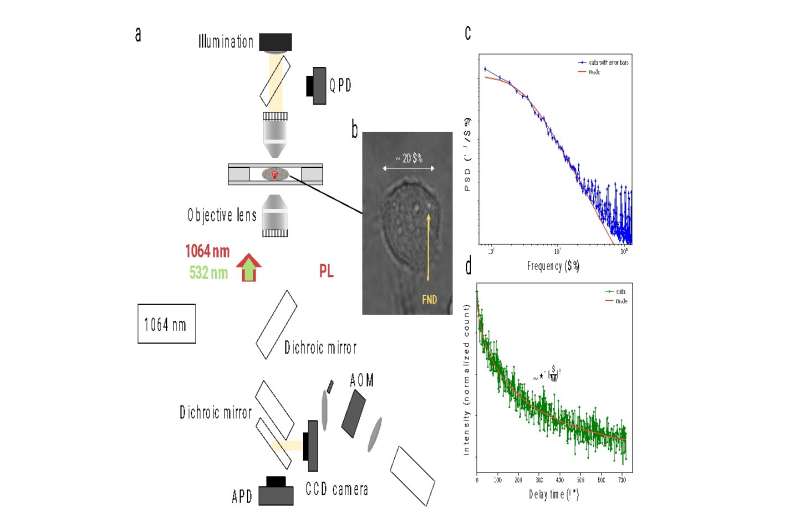
Researchers have developed a new
way to study the intricate dynamics within living cells by using optically
trapped nanodiamond particles as intracellular sensors. Using custom built
optical tweezers, the research team trapped the particles within the cell at
low power while the cell was alive. The work represents an important
advancement in quantum sensing, which takes advantage of quantum mechanics to
analyze changes at the atomic level.
The researchers used optical tweezers to trap nanodiamond particles inside single leukemia cells and then demonstrated how the particles can be used to measure magnetic noise within the cell. Fatemeh Kalantarifard from Technical University of Denmark will detail the work at Optica's Biophotonics Congress being held in Vancouver, British Columbia and online April 23–27, 2023. Kalantarifard's presentation is scheduled for Monday, April 24.
Optically trapped nanodiamonds
Fluorescent nanodiamonds (FNDs) have raised interest as promising emitters and sensors for various applications. One of the most remarkable properties of FNDs is detection of physical parameters, including temperature and magnetic field, by quantum sensing. Diamond quantum sensing is based on a paramagnetic defect in diamond, the nitrogen vacancy (NV) center, which allows reading out temperature and magnetic field dependent electron spin at the nanoscale.
Recently, researchers have used fluorescent nanodiamonds containing NV centers as intracellular sensors. In the work presented at the conference, researchers combined trapping of FNDs with spin-based photoluminescence measurement techniques common in diamond-based sensing in a single cell. FNDs were first endocytosed by cells from a human leukemia cell line, and they were then trapped by a near IR laser (1064 nm wavelength) at low power while the cell remained alive.
Nanoscale sensing
Once the nanodiamonds were in place within the cells and/or on the cell surface, the researchers conducted T1 relaxometry measurements to test their sensing capabilities. This method involves switching on and off a Green (532 nm wavelength) laser pulse that polarizes the electron spins of the NV centers and then lets them revert to equilibrium. Since the polarized configuration exhibits stronger fluorescence than the equilibrium state, researchers determine the spin relaxation rate by optically monitoring the intensity level of fluorescence.
Because the magnetic noise in the surrounding environment affects the spin relaxation rate, comparing spin relaxation rates between nanodiamonds positioned in different places allows researchers to map the magnetic noise within the cell. The demonstration shows that optically trapped fluorescent nanodiamonds could represent a precise and flexible method to analyze properties such as magnetic field and temperature within living cells.
"The combination of optical trapping of diamond nanoparticles and nanodiamond-based quantum sensing can provide a powerful tool for studying cell mechanical properties. Optical trapping can help hold the nanodiamond-based sensors with high precision, allowing for more accurate measurements at the nanoscale level. In particular, T1 relaxometry measurements of optically trapped nanodiamonds can be used for free radical detection in cells.
"Free radicals are highly reactive molecules that can cause damage to cells and tissues. They are produced naturally in the body because of metabolism and can also be generated by exposure to environmental factors such as radiation or toxins," said Kalantarifard.
"The use of optically trapped nanodiamonds for free radical detection offers several advantages, including high sensitivity, non-invasiveness, and the ability to monitor real-time changes in T1 relaxation time. This technique can be used to study the effects of oxidative stress on cells and may have potential applications in the diagnosis and treatment of diseases such as cancer and neurodegenerative disorders."

 Previous page
Previous page Back to top
Back to top







